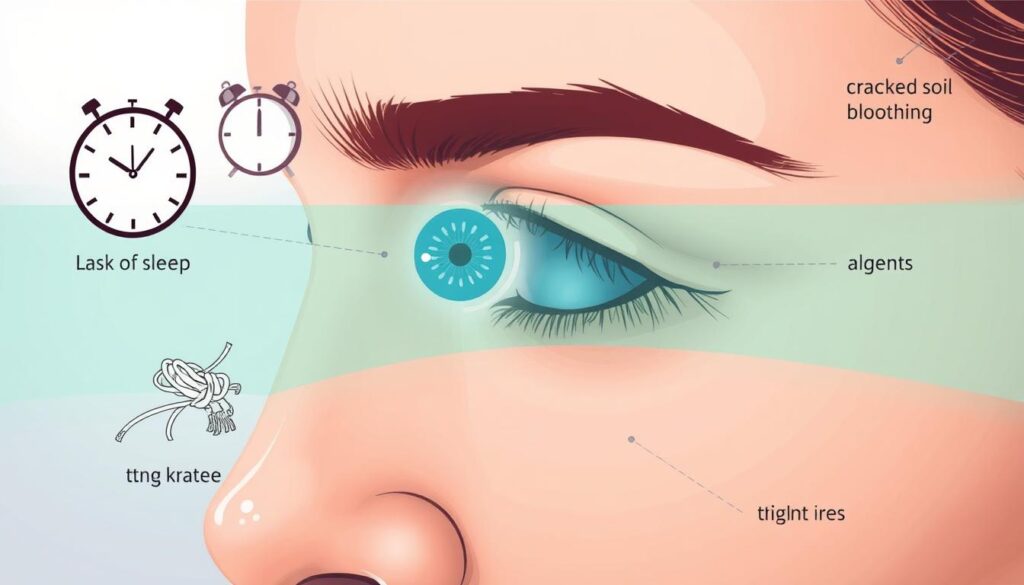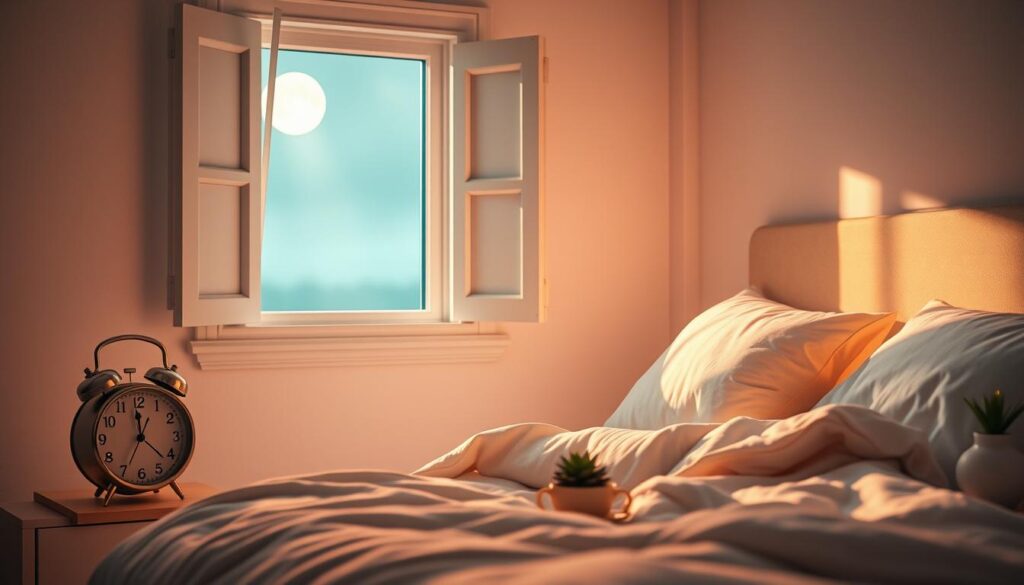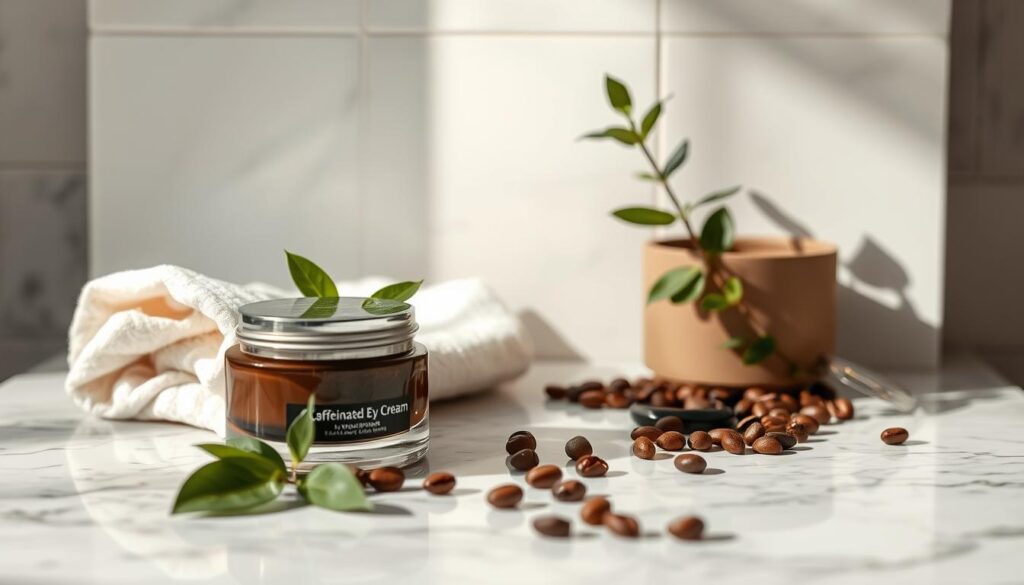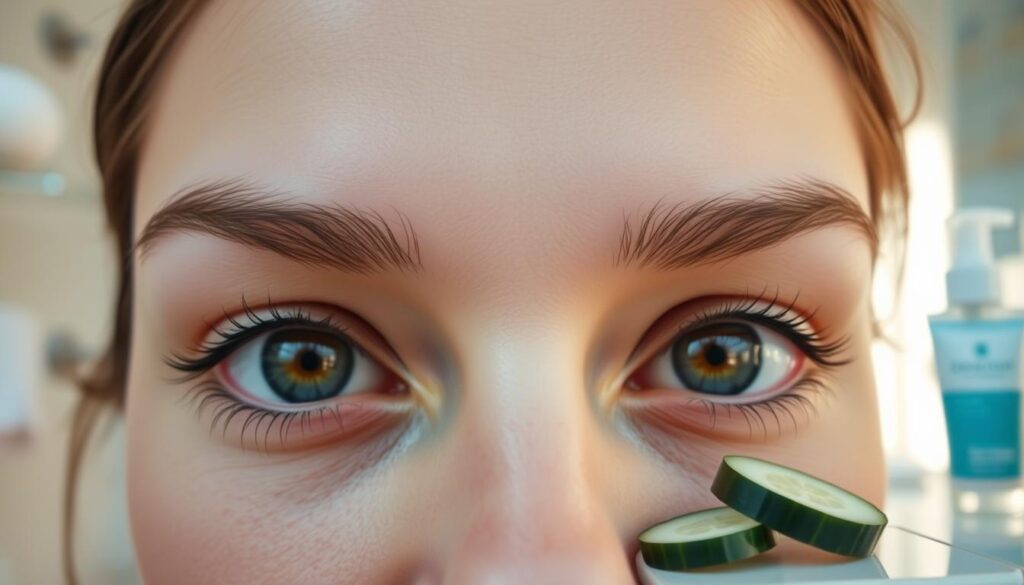Are dark circles ruining your bright-eyed look? Don’t worry, there are many ways to make them less noticeable1. Dark circles, or periorbital hyperpigmentation, affect millions worldwide1. They’re common in adults, but can happen to anyone1.
Learn how to wake up with a refreshed look. Our guide will show you how to reduce dark circles.
Key Takeaways
- Dark circles can be caused by genetic factors, aging, lifestyle choices, and medical conditions.
- Getting enough sleep and staying hydrated are essential for minimizing dark circles.
- Topical treatments like eye creams and vitamin C can help target puffiness and discoloration.
- Protecting the delicate eye area from UV exposure and managing allergies can also reduce dark circles.
- In some cases, cosmetic treatments like laser therapy and fillers may be necessary to achieve desired results.
Causes of Dark Circles

Dark circles around the eyes can come from many things. These include genetics and how your body is built, poor blood flow, and lifestyle choices.2 Knowing what causes them is key to finding ways to make them less noticeable.
Genetics and Anatomical Factors
Some people are more likely to have dark circles because of their genes and eye area structure3. Nonwhite heritage makes it more common in darker skin tones3. Also, as we get older, less fatty tissue and thinner skin around the eyes make dark circles stand out more3.
Poor Circulation
Not enough blood flow to the skin under the eyes can cause blood to pool. This makes the area look dark and shadowy2. This issue can get worse from not getting enough sleep, being stressed, and some health problems2.
Lifestyle Choices
Some lifestyle choices can lead to dark circles. These include smoking, drinking too much alcohol, and not drinking enough water2. Also, allergies and rubbing your eyes can make dark circles look worse2.
By knowing what causes dark circles, people can start to fix the problems. This way, they can make their eye area look better234.
Importance of Getting Enough Sleep

Getting enough sleep is key to reducing how to reduce dark circles. Lack of sleep makes blood vessels under the eyes swell. This makes them more visible, causing dark circles5. Over a third of American adults get less than seven hours of sleep daily5.
Experts say sleeping on your back with an extra pillow helps. It prevents blood from pooling around the eyes6. The Journal of Clinical and Aesthetic Dermatology found dark circles affect emotional health and quality of life6. A consistent sleep routine and avoiding blue light before bed also helps.
A small study found sleep-deprived people look sadder and more tired than those well-rested.56 Dark circles can signal sleep deprivation and fatigue, but there’s limited evidence on beauty sleep reducing them.5
Poor sleep habits can make hair greasy and lead to dandruff. It can also cause hair loss due to stress hormone cortisol.5
“Sleep deprivation causes vasodilatation and increased blood flow, leading to dark bluish circles under the eyes,” says sleep neurologist Dr. Chris Winter.
Dark circles under the eyes worry dermatologists and specialists, as shown in The Journal of Clinical and Aesthetic Dermatology research.6 The American Academy of Ophthalmology advises seven to nine hours of sleep nightly to reduce dark circles6.
Lifestyle factors like dehydration, stress, and rubbing the eyes contribute to dark circles6. Dermatologists suggest treatments like dermal fillers, laser treatments, and skin bleaching65.
Cold Compresses and Caffeinated Eye Creams

Dark circles can be a daily problem, but there are easy fixes. Cold compresses or cooling tools can help. They make the blood vessels under your eyes smaller, making dark circles less noticeable7.
Eye creams with caffeine are also great for dark circles. Caffeine shrinks blood vessels, reducing discoloration7. A study showed caffeine eye cream can improve puffiness and dark circles right away7.
Constricting Blood Vessels
Cold compresses or tools can make dark circles less visible. They provide a quick fix to look refreshed7.
Reducing Puffiness
The cold also reduces puffiness, which makes dark circles less noticeable. This reduces swelling and inflammation7.
Caffeine in eye creams tightens and brightens the eye area7. It gives you a refreshed look, even with dark circles7.
“Caffeine-based eye creams are a game-changer for reducing the appearance of dark circles and puffiness.”
Protecting the Eye Area from UV Exposure
UV light can cause dark circles by making the skin around the eyes darker8. It’s important to protect this area from the sun. Use sunscreen, wear hats, and sunglasses outside to block UV rays8. This helps prevent dark circles from getting worse and new ones from forming8.
The skin around the eyes is very thin and easily damaged by the sun8. Sun exposure can make dark circles worse by causing inflammation8. This happens to everyone, not just those with darker skin8. Summer is especially risky for sun damage under the eyes8.
Spring and summer allergies can also make dark circles look worse by causing puffiness8.
To protect the eye area, apply sunscreen every 90 minutes8. Use products with brighteners like retinol and niacinamide to fight dark spots8. For more serious issues, try non-invasive treatments like lasers and microneedling8.
By shielding the eye area from UV rays and using good skincare, you can reduce dark circles8. Healthy habits like enough sleep, eating anti-inflammatory foods, and staying hydrated also help8910.
| Risk Factors for Dark Circles | Impact |
|---|---|
| Genetics and Anatomy | People genetically predisposed to developing dark circles are more prone to the appearance of this concern10. |
| Aging | As we grow older, dark circles tend to increase due to the thinning and reduced elasticity of the skin10. |
| Skin Tone | Dark circles are more frequently observed in individuals with darker skin tones10. |
| Fatigue and Tiredness | Fatigue is a major contributing factor to the development of dark circles10. |
| Allergies | Allergic reactions can lead to the appearance of dark circles due to the release of histamines10. |
| Medical Conditions | Conditions like anemia, characterized by lower red blood cell levels, can be a source of dark circles10. |
| Lifestyle Factors | Excessive drinking, smoking, and poor hydration habits can contribute to the development of dark circles10. |
Managing Allergies and Preventing Eye Rubbing
Allergies can make dark circles worse. When you react to an allergen, your eyes get inflamed. This can lead to dark circles11. But, managing your allergies can stop this cycle and reduce dark circles11.
Allergic shiners look like bruises under your eyes. They’re mainly caused by allergies11. Symptoms include shadowy skin, blue or purple tint, and watery, itchy eyes11.
Seasonal and indoor allergens can cause these symptoms11. Pollen and dust mites are common culprits11. Avoid rubbing your eyes to keep the skin around them healthy11.
There are ways to manage allergies and stop eye rubbing11. Medications and lifestyle changes can help11. Using air conditioning and cleaning regularly can reduce allergens11.
Prescription drugs like montelukast (Singulair) can help but may cause mood changes11. Practical solutions like avoiding allergens and staying hydrated can also help11.
By tackling allergies and preventing eye rubbing, you can manage dark circles11. This will help you look brighter and more refreshed11.
How to reduce dark circles
Do you struggle with dark circles under your eyes? You’re not alone. Many things can cause dark circles, like fatigue, allergies, and aging. Even sun exposure and genetics play a role12. But, there are ways to make the skin around your eyes look brighter.
Topical Vitamin C: A Collagen Booster
Topical vitamin C is a great way to fight dark circles. It boosts collagen, making the skin thicker and less visible. Using a vitamin C eye cream or serum can really make a difference.
Vitamin K: Anti-Inflammatory Benefits
Vitamin K is also important for dark circles. It’s anti-inflammatory and can make the skin more hydrated and elastic. This can help reduce dark circles13. Look for eye products with vitamin K to help with shadows.
While these treatments work, they’re not a permanent fix. To keep your eyes looking bright, use them regularly and take care of your skin overall12.
“A study in 2015 showed a reduction in wrinkle depth and dark circles under the eyes with the use of a pad containing caffeine and vitamin K.”12
Prescription Skin-Lightening Products
For those with lasting dark circles, prescription skin-lightening products might help. These products, with ingredients like hydroquinone, kojic acid, or arbutin, block melanin production. This is the pigment that makes the skin around the eyes look dark14.
But, it’s important to use these products carefully. They can cause mild side effects like burning, stinging, redness, and dryness14. In some cases, more serious issues like blistering, skin cracking, and darkening of the skin can happen14. Rarely, severe allergic reactions may occur, showing as rash, swelling, dizziness, and trouble breathing14.
People with skin conditions, allergies, or other health issues should talk to a dermatologist or pharmacist first14. Pregnant women should also be cautious, as the effects on breast milk are not fully known14.
When used right and with a doctor’s advice, these products can help reduce dark circles and other pigmentation15. Knowing the risks and benefits helps people make smart choices for their skin15.
| Ingredient | Function | Potential Side Effects |
|---|---|---|
| Hydroquinone | Inhibits melanin production | Mild burning, stinging, redness, dryness; Rare: blistering, skin cracking, blue-black darkening |
| Kojic Acid | Inhibits tyrosinase, an enzyme involved in melanin production | Skin irritation, redness, dryness |
| Arbutin | Inhibits tyrosinase, an enzyme involved in melanin production | Skin irritation, redness, dryness |
It’s key to use these products with a dermatologist’s guidance15. They can assess your skin and health needs15. This way, you can find safe and effective ways to tackle dark circles, while avoiding bad reactions15.
Concealer and Makeup Techniques
Treatments and lifestyle changes can help reduce dark circles. But, concealer and makeup techniques can also work well to hide them temporarily16. It’s key to use a color corrector before applying concealer. This helps mask dark circles by using a thin layer that doesn’t look cakey, especially for photos16.
Eye cream is essential for hydrating the skin. This ensures that concealer and corrector products blend in well, as makeup artist Maria Asadi advises16.
Color Correcting
Using peach or yellow-toned formulas can neutralize dark circle colors17. The under-eyes are naturally darker because of thinner skin and more blood vessels17. Dry skin can make dark circles look worse, affecting how concealer works17.
Eye creams can plump up the skin and hide veins17. Caffeine in these creams can also shrink blood vessels17. Peach, yellow, or orange color correctors can help neutralize under-eye circles17.
Concealer Application Tips
16 Blend foundation under the eyes with a thin layer, especially for those with neutral skin tones16. Use a damp beauty sponge for a smooth finish16. Choose a light-reflective concealer a shade lighter than your skin to brighten the area, advises Asadi1617.
For fine lines, use a matte and firm concealer. For smoother skin, opt for a hydrating liquid formula, Asadi suggests1617. Thicker balm concealers in lighter shades can make the eyes look lifted. Use liquid concealers closer to your skin tone to cover bags with an inverted triangle technique1716.
Set your makeup with blotting papers to reduce shine. Then, apply setting powder with a small brush. Makeup artist Daniel Bauer recommends using translucent powder to avoid caking1617. This powder helps smooth out texture and prevents concealer from creasing17.
Lifestyle Changes for Bright Eyes
Changing your lifestyle can help reduce dark circles. Drinking enough water prevents water retention and puffiness18. Also, eating less salt helps avoid puffiness and dark circles18. These changes can make your eyes look brighter and younger.
Staying Hydrated
Drinking enough water is key for healthy skin, especially around the eyes. Dehydration makes dark circles and puffiness worse19. Aim for 7-9 hours of sleep each night to keep your skin looking bright1819.
Reducing Salt Intake
Eating less salt can also help. Too much salt causes water retention and puffiness18. Eating foods rich in nutrients and avoiding processed foods helps your skin stay healthy19.
By making these lifestyle changes, you can enhance the effects of other treatments. Remember, addressing the causes of dark circles is crucial for lasting results1819.
When to Consult a Dermatologist
Many home remedies and over-the-counter products can help with dark circles under the eyes. But, there are times when you should see a dermatologist20. If the dark circles don’t go away or are part of other skin issues, a dermatologist can help20.
A dermatologist can find out why you have dark circles and suggest the best treatment. This might include stronger products or treatments like laser therapy or soft tissue fillers.
There are certain times when you should see a dermatologist for dark circles20. If home remedies and over-the-counter products don’t work, a skin care specialist can help20. Also, if the dark circles are very bad or come with other skin problems, a dermatologist can find the cause and treat it20.
Dermatologists can figure out if dark circles are from your lifestyle, genes, or health problems21. They can find the cause and suggest the best way to make your eyes look better.
If you’re not sure if you need to see a dermatologist, it’s best to make an appointment20. They can give you advice that fits you and help your eyes look brighter and younger22.
While home remedies and over-the-counter products are useful, sometimes you need to see a dermatologist for dark circles20. With their help and a plan made just for you, you can fix the problem and have healthier, brighter eyes21.
Conclusion
Dark circles can be a common and frustrating skin concern. But, with the right approach, you can effectively minimize their appearance. By addressing the root causes, such as genetics, poor circulation, and lifestyle factors, you can make a difference.
Incorporating a combination of remedies is key. This includes cold compresses, caffeine-infused eye creams23, and protecting the eye area from UV exposure. Managing allergies and using topical vitamin C and K23 also helps. Plus, mastering concealer techniques can make a big difference.
Remember, if home treatments don’t work, consulting a dermatologist may be beneficial24. The cosmetic industry is always finding new ways to address dark circles and hyperpigmentation24. This means there are many solutions to help you feel more confident in your skin.
By following a comprehensive approach, you can reduce the appearance of how to reduce dark circles. This will help you achieve the summary of tips to reduce dark circles you desire. With the right strategies and patience, you can say goodbye to dark circles and enjoy a brighter, more youthful-looking eye area.
FAQ
What causes dark circles under the eyes?
Dark circles can come from many things. Genetics, poor blood flow, and lifestyle choices like not sleeping enough, stress, and dehydration play a part. Also, what you eat, drinking alcohol, and allergies can cause them too.
How important is getting enough sleep for reducing dark circles?
Getting enough sleep is key to lessening dark circles. Without enough sleep, blood vessels under the eyes can swell. This makes them more visible and darkens the area.
How can cold compresses and caffeinated eye creams help with dark circles?
Cold compresses or cooling tools can shrink blood vessels under the eyes. This reduces dark circles. Eye creams with caffeine do the same thing by tightening blood vessels.
Why is it important to protect the eye area from UV exposure?
UV light can cause dark circles by making the skin around the eyes darker. Using sunscreen, wearing hats, and sunglasses helps prevent this. It also stops dark circles from getting worse.
How can managing allergies and preventing eye rubbing help with dark circles?
Allergies can make dark circles worse because of inflammation and rubbing. Managing allergies and avoiding rubbing your eyes helps. This stops the cycle of inflammation and rubbing, reducing dark circles.
What are the benefits of using topical vitamin C and vitamin K for dark circles?
Vitamin C boosts collagen, making the skin thicker and less visible. Vitamin K reduces inflammation and improves skin hydration and elasticity. Both can help lessen dark circles.
When should you consider using prescription skin-lightening products for dark circles?
If dark circles are from hyperpigmentation, prescription products like hydroquinone or arbutin might help. But, always talk to a dermatologist first. These products can have side effects if not used right.
How can concealer and makeup techniques help minimize the appearance of dark circles?
Peach or yellow formulas can neutralize dark circle colors. A high-coverage concealer can cover them up. Learning how to apply concealer properly can greatly improve the look of your under-eye area.
What lifestyle changes can help reduce the appearance of dark circles?
Drinking enough water and eating less salt can prevent puffiness. These simple changes can help other treatments work better. They make your eyes look brighter and more youthful.
When should you consult a dermatologist for dark circles?
If home remedies and store-bought products don’t work, or if dark circles are persistent, see a dermatologist. They can find the cause and suggest the best treatment.
Source Links
- How to Get Rid of Dark Circles under the Eyes: Expert Tips for a Fresh, Clear Look – The Youth Fountain
- Dark circles under eyes Causes
- Dark circles under the eyes: Causes and treatments
- Dark Circles Under Your Eyes: Causes, Treatments, and More
- Beauty Sleep: Why Rest and Relaxation Impact Appearance
- Does Lack of Sleep Really Give You Dark Circles Under Your Eyes?
- The INKEY List Caffeine Eye Cream
- How to Brighten Dark Circles Caused by Sun Exposure
- Tips For Preventing Under Eye Bags and Dark Circles – Spa MD
- Can Sun Exposure Cause Dark Circles? | Mccracken Eye And Face Institute – Blog
- Allergic Shiners: Symptoms, Causes, and Treatment
- How To Get Rid of Dark Circles Permanently
- Different Ways to Reduce Dark Circles – Dermatology Center of Northwest Houston
- Hydroquinone Skin Bleaching Topical: Uses, Side Effects, Interactions, Pictures, Warnings & Dosing – WebMD
- Options for Skin Lightening – Dr. Michele Green M.D.
- How to cover dark circles with makeup, according to the pros
- How to Flawlessly Conceal Under Eye Bags and Circles
- 16 Foods and Vitamins That May Help Reduce Dark Circles
- Bright Eyes: Proven Tips to Reduce Dark Circles and Puffiness
- Dark circles under eyes When to see a doctor
- Um, PSA: There’s a New Fix for Dark Circles at Your Derm’s Office
- Can a Dermatologist Eliminate Dark Circles under the Eyes? – Mayoral Dermatology
- How to remove dark circles under eyes permanently
- Infraorbital Dark Circles: A Review of the Pathogenesis, Evaluation and Treatment

